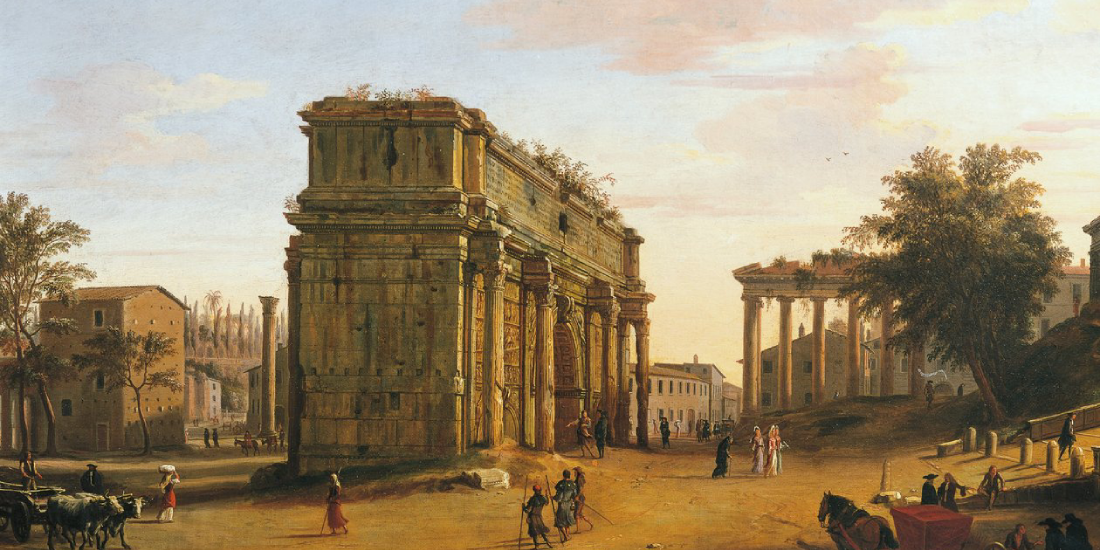
Vanvitelli's Arch of Septimius Severus in Rome: when art meets archaeology
Jayde BrowneShare
Vanvitelli's "The Arch of Septimius Severus in Rome" represents one of Gaspar van Wittel, known as Vanvitelli, most significant views of the monuments of ancient Rome. The painting captures a sweeping view of the Eternal City's archaeological heart, where the majestic white marble triumphal arch dedicated to Emperor Septimius Severus dominates the central composition. The ancient architecture emerges solemnly from the accumulation of debris and vegetation that over the centuries had buried much of the Roman Forum, testifying to the site's historical stratification.
The scene is populated by small human figures that lend scale and a sense of daily life to the archaeological landscape. Shepherds with their flocks, travelers, and onlookers enliven the ancient pavement, creating a striking contrast between the imperial grandeur of the past and the pastoral dimension of the present. The overall atmosphere conveys that romantic melancholy typical of ancient ruins, where time has transformed the center of Roman power into a bucolic landscape dotted with monumental remains that emerge as silent witnesses to a lost glory.
BUY THE REPRODUCTION OF"ARCH OF SEPTIMIUS SEVERUS" BY GASPAR VAN WITTEL

Style
Van Wittel’s stylistic approach in this archaeological veduta fits perfectly within the Baroque tradition of view painting, characterized by meticulous topographical observation combined with a picturesque sensibility for the historical landscape. The Dutch artist applied to the representation of Roman ruins the same rigorous methodology that marked his contemporary urban views, combining documentary precision with compositional refinement. The painting reveals the influence of the Northern European landscape school in its atmospheric rendering and attention to naturalistic detail.
The period of execution, datable between the late 17th and early 18th centuries, coincides with a renewed fascination with classical antiquity that pervaded European culture of the time. Van Wittel distinguished himself from his contemporaries by adopting a scientific approach to archaeological representation, avoiding the fanciful reconstructions typical of the period and instead privileging faithful documentation of the monuments’ actual condition. His pictorial technique unites the Flemish tradition of oil on canvas with an innovative sensitivity to Mediterranean light effects.
Color and lighting
The chromatic palette of the work is built around the warm tones of ancient stone, dominated by ochres, golden browns, and pearly grays of marble. Van Wittel demonstrates particular mastery in rendering the varying surface qualities of stone materials, from the weathered travertine of the arch to the still-shining marble of certain architectural fragments. The soft greens of spontaneous vegetation colonizing the ruins create delicate chromatic counterpoints, while the blues of the Roman sky provide a luminous frame to the composition.
Light falls from the left with the golden quality typical of Mediterranean illumination, which Van Wittel had learned to appreciate during his Italian sojourn. The interplay of light and shadow enhances the architectural plasticity of the Arch of Septimius Severus, highlighting the sculptural reliefs and classical moldings. The distribution of light creates a visual progression guiding the eye from the shaded foreground toward the luminous sky, imparting depth and breadth to the archaeological view.
Spatial organization
The spatial construction of the work reveals Van Wittel’s mastery in handling monumental perspective. The Roman Forum opens before the viewer like a vast natural amphitheater, where architectural elements are arranged according to a spatial logic faithful to the site’s real topography. The Arch of Septimius Severus, placed slightly off-center, serves as the compositional fulcrum around which other monuments are organized: the slender Column of Phocas to the left and the remains of the Temple of Saturn to the right.
Depth is articulated through overlapping planes, from the detailed foreground with figures and debris to the hilly background closing the horizon. Van Wittel employs aerial perspective to convey distance, progressively lightening tones and softening contrasts toward the background. The presence of accumulated earth and vegetation attests to the burial that characterized the Forum in the artist’s time, when monuments emerged only partially above the modern ground level.
Composition and framing
The framing chosen by Van Wittel embraces a wide portion of the Roman Forum, allowing viewers to perceive both the architectural details of individual monuments and the overall spatial relationship of the archaeological site. The composition follows the principles of asymmetrical balance: although the Arch of Septimius Severus occupies the central position, it is counterbalanced by the column and surrounding ruins. The compositional lines naturally converge toward the main monument, while the distribution of architectural masses creates a visual rhythm that guides the reading of the ancient landscape.
The elevated viewpoint makes it possible to appreciate the site’s breadth and the relationship between the various buildings, offering a unified image of the Forum complex. Small human figures, strategically distributed within the composition, provide scale references and animate the scene with touches of vivid color. The choice of framing reveals a scenographic conception of the archaeological veduta, in which every element contributes to shaping an image of Rome that unites historical documentation and pictorial suggestion.
Technique and materials
The work is executed in oil on canvas, following the Flemish painting tradition that Van Wittel had thoroughly assimilated during his training in the Netherlands. The preparation of the pictorial surface, probably consisting of gesso and glue, provides a luminous ground that enhances the brilliance of the overlying pigments. The chromatic application proceeds through successive glazes, producing the distinctive atmospheric quality that characterizes the Dutch master’s Italian views.
The pigments used attest to the high quality of the materials employed: natural earths for the ancient architecture, ultramarine for the sky, and copper greens for the vegetation. Van Wittel’s brushwork reveals an extremely controlled technique, particularly evident in the definition of architectural details and the rendering of varied stone textures. The artist demonstrates a remarkable ability to convey the effects of time on ancient materials—from marbles polished by the elements to travertine eroded by age. His execution method combines descriptive precision with painterly sensibility, achieving a perfect balance between archaeological documentation and artistic interpretation of the Roman landscape.
